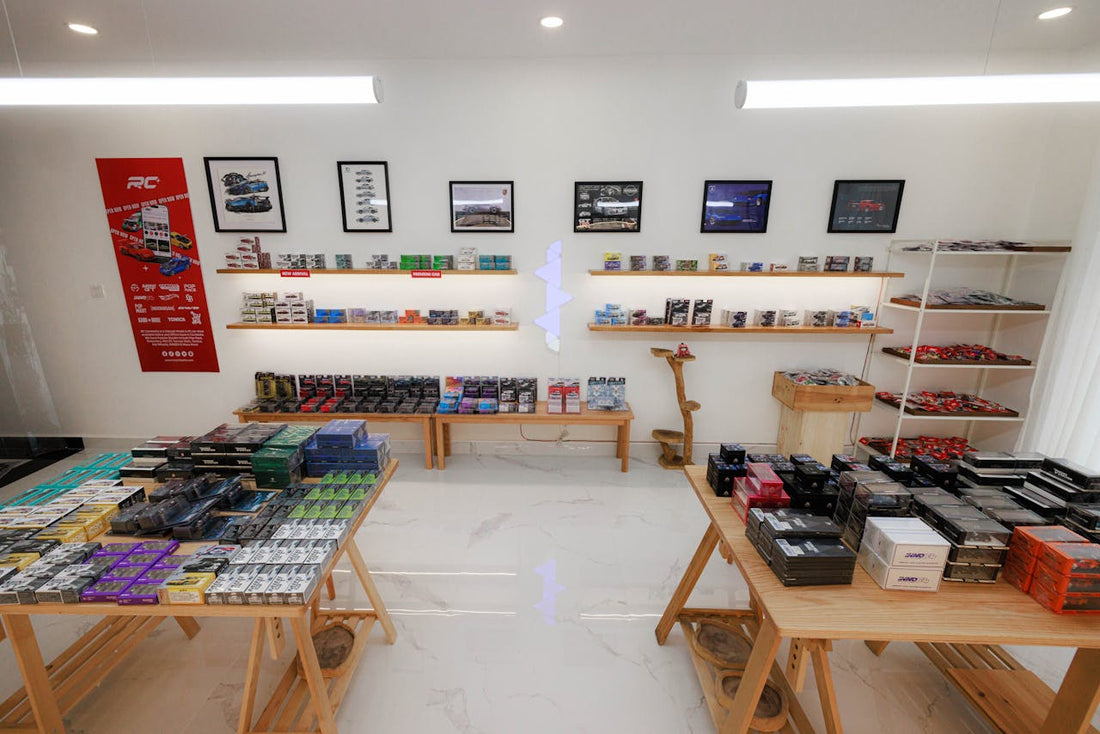Today’s global trade wars are hitting even the most innocent of pastimes. For generations, building scale models – from Gundam robots to model trains – has been a beloved hobby. But now that hobby faces what one industry analysis calls an “existential threat,” as tariff battles drive up costs and disrupt supply chains, potentially turning a vibrant nicheinto a relic of the past (freightwaves.com). The effects are being felt most in countries like China and Japan, where the bulk of model kits and accessories originate. This article explores how U.S. tariffs are rippling through the hobby industry, squeezing small retailers, and even forcing changes from major Japanese manufacturers. We’ll look at the impact on imports from China and Japan and how hobby stores are fighting to keep the shelves stocked – and their passion alive.
Trade War Fallout on Hobby Shops (China in Focus)

Inside a U.S. hobby shop stocked with model kits and RC toys. Small retailers like this have felt the squeeze from tariffs on imported inventory.
The United States’ trade dispute with China has put hobby stores squarely in the crossfire. Tariffs on Chinese-made goods – which include a huge array of hobby products – have skyrocketed into unprecedented territory, with some import duties soaring as high as 125%–145% on top of standard rates (fox4now.com). For small retailers, these sudden taxes hit the bottom line overnight. “Pretty much across the board… prices have gone up at least 10%, some products more,” said one Florida hobby shop owner after his distributors raised wholesale prices in response to new tariffs (fox4now.com). He described the challenge of keeping up with ever-changing costs: “It’s the uncertainty, not knowing what the percentage is going to be… there’s just a lot up in the air right now” (fox4now.com). In short, planning ahead has become nearly impossible when tariff rates can change almost weekly.
Crucially, hobby retailers have no domestic alternatives to turn to. These niche products – plastic model kits, radio-control toys, miniature parts – are virtually all made in China or elsewhere in Asia. “Even companies that do designing in the U.S., they still have their parts made and manufactured and assembled overseas,” the shop owner explained (fox4now.com). There are simply no American manufacturers who can readily supply these items, so stores are forced to either pay the tariff-inflated costs or stop carrying the products. In other words, contrary to the notion that tariffs punish foreign exporters, the reality is “tariffs are paid by Americans, by American businesses” – ultimately passed on to U.S. importers, shops, and consumers (uschamber.com).
The impact of these tariffs on the hobby supply chain has been swift and severe. A recent industry report described a cascade of problems already unfolding due to tariff hikes:
-
Frozen inventory: Incoming shipments of new model products have been put on hold or stuck in customs.
-
Cancelled releases: Orders for upcoming kits and model lines are being canceled, and production runs have ground to a halt in factories.
-
Cash flow crunch: Small importers find themselves unable to clear full containers of goods or finance future shipments under the crushing new costs.
-
Empty shelves: Retailers are not receiving expected pre-ordered stock, forcing entire product lines to be shelved and leaving hobby enthusiasts empty-handed (freightwaves.com).
These outcomes illustrate how a tariff intended for broad economic pressure can devastate a niche industry. The model railroad sector, for example, relies on razor-thin margins and long pre-order cycles, leaving “no room for sudden price adjustments” when a shipment lands with an unexpected 100%+ duty (freightwaves.com) (freightwaves.com). The result isn’t just higher prices – it’s existential. Without relief, observers warn that permanent store closures and the disappearance of generational hobby brands are real possibilities (freightwaves.com).
Ripples in Japanese Model Kit Supply
Japan is home to some of the most famous model kit brands – Bandai’s Gundam (Gunpla) line, Tamiya, Kotobukiya, and others. Notably, Japanese-made kits have not been directly subject to the U.S. tariffs aimed at China. In fact, savvy enthusiasts found that importing Gunpla models produced in Japan allowed them to avoid the added costs hitting Chinese-origin goods. U.S. retailers likewise tried pivoting to Japanese suppliers to keep products flowing without the 25%+ tariff penalty.
However, this strategy has not been foolproof. If any item in a shipment from Japan is actually manufactured in China, U.S. customs still slaps the high tariff on that item – and that can ruin an entire order’s economics. In May 2025, one California hobby store learned this the hard way. They brought in one of their largest shipments ever from Japan, only to discover that some model kits had a “Made in China” country of origin. Those particular products were hit with a massive 125% import tariff, creating an astronomical customs bill (fox4now.com). This unexpected cost inflicted major financial stress on the small business. Since then, they’ve had to halt direct imports from Japan entirely, because the risk of hidden Chinese-origin components turned each order into a potential financial landmine. With their usual supply line cut off, the store’s inventory began dwindling week by week, and popular kits grew harder to restock. It’s a story that underscores how deeply interconnected the hobby supply chain is with global manufacturing – and how trade policies can have unintended collateral damage.
Japan’s model kit industry is now grappling with challenges of its own, which in turn affect hobbyists worldwide. BANDAI SPIRITS – the company behind Gundam plastic models – announced it would raise model kit prices for the first time in over 40 years, due to steep increases in raw materials, packaging, and logistics costs (us.oricon-group.com). Starting in April 2025, Bandai began adjusting the suggested retail prices on many kits. For example, the classic HG 1/144 Gundam Exia kit jumped from ¥1,320 to ¥1,540, and the deluxe MGEX 1/100 Strike Freedom Gundam rose from ¥15,400 to ¥17,050 (us.oricon-group.com). These are significant hikes for hobbyists on a budget. Additional rounds of price increases are slated for later in the year – Bandai noted that further adjustments for products released after July 2025 will be announced quarterly on its website (us.oricon-group.com). In short, even as American retailers find ways to source Japanese kits amid tariffs, the prices of those kits are climbing at the source. Hobby store owners fear a double squeeze: import tariffs on one hand and manufacturer price hikes on the other, both ultimately translating to higher shelf prices for the end customer.
Adapting to a Changing Hobby Market
Faced with these headwinds, hobby retailers and distributors are not standing idle. Many are scrambling to adapt their business models to survive the tariff era. For instance, the California shop that lost its Japan supply line took proactive steps to diversify its sourcing – the owner reached out and formed partnerships with five new distributors in the past few months. By broadening their supplier network (including working with wholesalers in other regions), they’ve been able to gradually replenish stock despite the import restrictions. Moves like this can help spread out the risk; if one supply route is cut off or taxed prohibitively, an alternate source might still provide certain kits or accessories. Retailers are also carefully managing their inventory and pricing – some are slowing down on new orders of high-tariff items, while others incrementally adjust prices in-store to share part of the burden with consumers without driving them away.
On an industry-wide level, there are calls for policy adjustments to shield the hobby sector. Trade associations and hobby business coalitions have been lobbying for the reinstatement of tariff exemptions (exclusions) that previously applied to niche hobby products (freightwaves.com). They point out that products like model kits and model trains were never the target of anti-dumping rules or national security concerns – these goods were even explicitly excluded from tariffs in the past due to their specialized nature. Removing that exclusion now lumps them in with mass-market toys and industrial goods, an approach critics say misses the mark. Without relief, they warn, a cherished piece of hobby culture could vanish. As one plea noted, this industry isn’t asking for a handout, just a recognition that punitive tariffs aimed at other industries shouldn’t kill off a harmless enthusiast hobby (freightwaves.com). Whether through renewed exclusions, lower tariff rates, or other trade agreements, any easing of the pressure would be welcomed by the hobby community. (Indeed, a temporary U.S.–China accord in mid-2025 did reduce tariffs on Chinese-made hobby goods down to about 30% from the prior triple-digit levels (support.hlj.com) – a hopeful sign, though it may be only a short-term pause.)
Hobby shop owners also emphasize the importance of community support during these tough times. They note that giant e-commerce retailers can weather cost increases or pivot to different product lines, but a small family-run hobby store has slim margins and limited capital. “In times like these when we’re seeing potential price increases and issues with tariffs, now is the time to support your local people,” urged one longtime shop owner (fox4now.com). Big box retailers or online marketplaces might absorb a tariff hit with ease, “but the small guy… can’t afford to take a huge hit,” he explained (fox4now.com). By patronizing local hobby shops, customers not only keep those businesses afloat but also help maintain the unique expertise and community spaces they provide. Many stores have built loyal customer bases over decades; that loyalty is now more critical than ever.
Ultimately, the fate of many hobby retailers may hinge on both policy and people. If trade barriers continue unabated, even the most passionate shop owners could be forced to scale back or shutter. But with creative adaptation – securing new suppliers, adjusting to price realities – and the steadfast support of hobbyists, these businesses are fighting hard to weather the storm. The model kit hobby has always been about patience and ingenuity, and now those qualities are being tested outside the workshop as well. By banding together, the community hopes to ensure that the only thing “going down in flames” are the model rockets at the club launch day – not the hobby industry itself.





